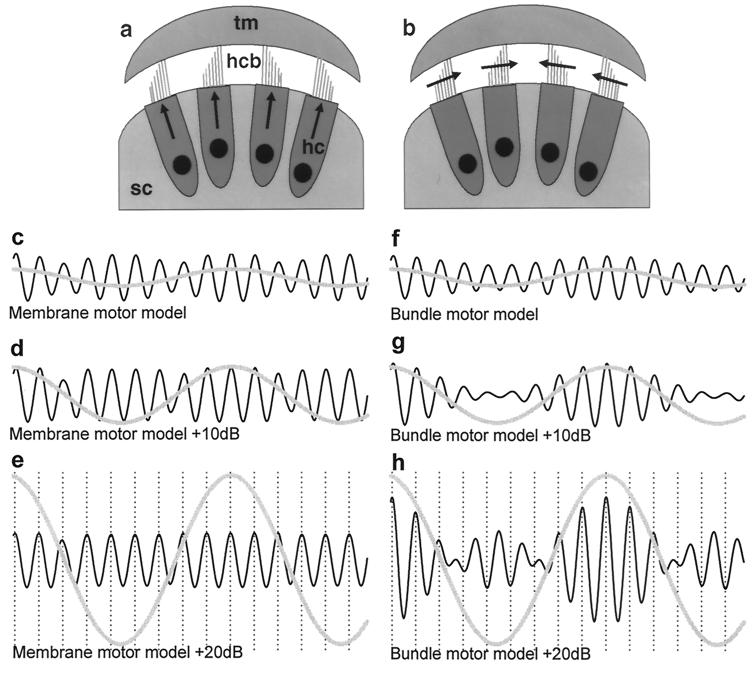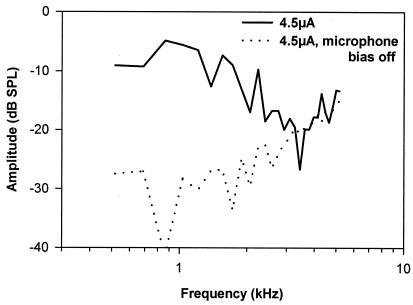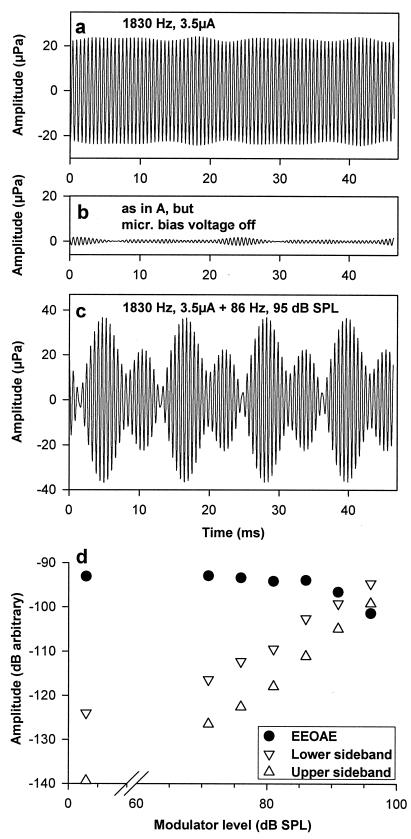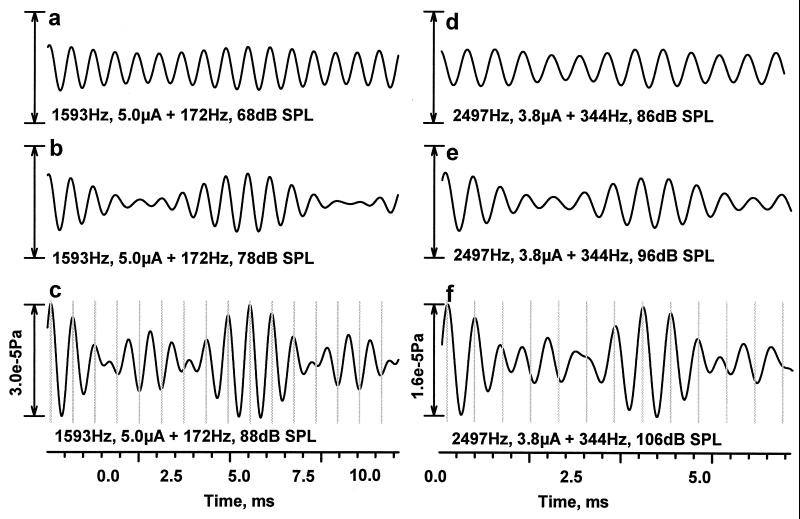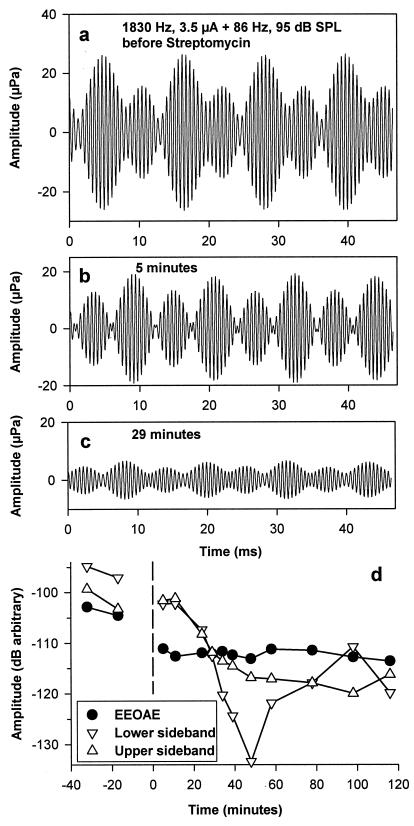Abstract
Vertebrate sensory hair cells achieve high sensitivity and frequency selectivity by adding self-generated mechanical energy to low-level signals. This allows them to detect signals that are smaller than thermal molecular motion and to achieve significant resonance amplitudes and frequency selectivity despite the viscosity of the surrounding fluid. In nonmammals, a great deal of in vitro evidence indicates that the active process responsible for this amplification is intimately associated with the hair cells' transduction channels in the stereovillar bundle. Here, we provide in vivo evidence of hair-cell bundle involvement in active processes. Electrical stimulation of the inner ear of a lizard at frequencies typical for this hearing organ induced low-level otoacoustic emissions that could be modulated by low-frequency sound. The unique modulation pattern permitted the tracing of the active process involved to the stereovillar bundles of the sensory hair cells. This supports the notion that, in nonmammals, the cochlear amplifier in the hair cells is driven by a bundle motor system.
In vertebrates, including humans, hearing at low sound levels is supported by a fast, mechanical amplifying system integral to the sensory hair cells (1, 2). Numerous phenomena have been attributed to this “cochlear amplifier” (3), including the ear's high sensitivity and frequency selectivity, but also faint sounds (otoacoustic emissions) generated spontaneously by sensory cells in the inner ear. These spontaneous otoacoustic emissions can be suppressed by adding tones, and the frequency selectivity of that effect clearly links spontaneous emissions to the hair cells (4). Spontaneous otoacoustic emissions and other indirect phenomena believed to indicate amplification by hair cells have been described from all tetrapods, suggesting that the underlying mechanisms are very old (4–6).
As potential origins of the hair-cell amplifier, two cellular mechanisms are currently under discussion. One involves conformational changes of molecules in the hair-cell lateral membrane, the other involves active movements of the stereovillar bundles atop the hair cells (7). In vitro, both rapid length changes of hair cells (1, 2) and rapid movements of hair-cell bundles (8–13) have been demonstrated. Evidence for length changes in the hair-cell body has come exclusively from work on isolated outer hair cells (OHC) or cochleae of mammals. Under voltage clamp, OHC movements can follow electrical stimulation up to very high frequencies (1, 2, 14, 15). The motor molecules are apparently confined to the lateral OHC membrane (16, 17), where tight clusters of particles are found (18, 19). Most recently, motility was elicited in kidney cells expressing an OHC gene for the protein Prestin (ref. 20, but see also ref. 21).
Much evidence also exists for a cochlear amplifier in lizards and birds for frequencies up to at least 10 kHz (4), yet nonmammals lack cells resembling mammalian OHC. Direct evidence for rapid movement of hair-cell bundles comes mainly from in vitro studies of nonmammalian vestibular systems (reviews in refs. 7 and 8, also in refs. 11–13), but also from studies of the hearing organ of turtles (9, 10). These data indicate that the molecular mechanisms responsible are directly associated with the transduction channels. Because these channels are directly gated by the stimulus, coupling a source of mechanical power to the channel gating permitted the development of an amplification system closely associated with the transduction process itself (7). Recent theoretical discussions (22–24) suggest that motor molecules in the hair-cell bundle can provide amplification by means of self-tuned critical oscillations. In all of these nonmammalian preparations, the response frequencies were well below 1 kHz, often below 100 Hz, and thus very low in the auditory range of vertebrates. To date, the origin of higher-frequency active processes in nonmammals is unclear, and there was previously no obvious way to distinguish between lateral membrane and bundle motors in intact organs. We have examined the origin of hair-cell motor activity in a whole-animal preparation, and present in vivo evidence that, in lizards, it is the hair-cell bundles that produce mechanical forces at audio frequencies.
In mammals, low-level ac electrical currents (5–10 μA) injected into Scala media elicit hair-cell motility manifest as electrically evoked otoacoustic emissions (EEOAE) in the external ear that have sound pressures up to 30 dB sound pressure level (SPL). EEOAE are assumed to originate from the same motility source that drives the cochlear amplifier (25–27). Low-frequency sounds modulate EEOAE in direct proportion to the sound-evoked current passing through OHC, suggesting that the imposed current passes through the open transduction channels of the stereovilli (26). Is it also possible to drive a bundle-based motor by using electrical current?
The auditory papillae of lizards always consist of at least two regions of hair cells arranged along the papilla's length. One region responds to frequencies below about 1 kHz, the other region to higher frequencies, generally with an upper limit near 5 kHz (28). Uniquely, the high-frequency regions of lizard auditory papillae usually consist of populations of hair cells whose stereovillar bundles are oppositely oriented (28), i.e., the directional sensitivities of the bundles have opposing polarities (see Fig. 2 a and b). This distinctive organization permits examination of the different putative active mechanisms in a way that is impossible in mammals and birds. We reasoned that if EEOAE could be evoked in lizards, this hair-cell arrangement should make it possible to determine whether the cochlear motors driven by the electrical current are in the lateral hair-cell membrane or are associated with the bundles. A simple model indicated that if EEOAE could be modulated by adding low-frequency sound, the site of the hair-cell motor could be delineated in vivo.
Figure 2.
A model for predicting EEOAE output under acoustical modulation. (a and b) Schematic basal cross-sections through the high-frequency area of the auditory papilla of Tiliqua rugosa to illustrate the influence of hair-cell orientation on EEOAE output for two possible locations for the motor driving the cochlear amplifier. The tallest stereovilli of the hair-cell groups on either side face the middle of the papilla. A hair-cell lateral membrane motor would drive all cells to elongate and shorten in phase (a, arrows) and EEOAE from different populations would add constructively. For a bundle-based motor, however, oppositely oriented bundles would move 180° out-of-phase (b, arrows) and EEOAE add destructively. tm, tectorial membrane; sc, supporting cells; hc, hair cell, hcb, hair-cell stereovillar bundle. When low-frequency sound is applied, the output from hair cells of one orientation decreases, whereas that of the other increases, the force from each type being of the same phase in the case shown in a and c--e and of opposite phase in the case b and f--h. A 5% excess of cells of one polarity is assumed, allowing a small EEOAE response at the resting point in f–h. The model uses the same frequency ratio between electrical and acoustical stimuli as in a–c in Fig. 4 (9.25:1). The time axes cover just over 1.5 cycles of the modulator. (c—e) EEOAE output (thin lines) of a model simulating lateral membrane motors stimulated by ac current and modulated by a low-frequency sound (thick line, placed on arbitrary axes relative to the EEOAE). Compared with c, the relative sound pressure of the modulator is increased by 10 and 20 dB in d and e, respectively. (f—h) As in c and d, but for motors in the hair cell bundle. Modulation increases EEOAE from one set of cells and reduces it from the other, depending on the phase of the modulating sound. Compared with f, the sound pressure of the modulator is increased by 10 and 20 dB in g and h, respectively. In e and h, the vertical lines emphasize the roughly 180° phase shift in the EEOAE in h at each half cycle of the modulator.
Materials and Methods
The experiments were carried out on nine adult Australian bobtail skinks (Tiliqua rugosa), captured in the wild under license in Western Australia. The animals weighed between 230 and 463 g and were anaesthetized with pentobarbital sodium and Diazepam (initial doses averaged 43 mg/kg and 1.8 mg/kg, respectively, typically followed by one-third doses of Pentobarbital every 1.5 h and a full Diazepam dose every 3 h). Esophageal temperature was kept at 30°C, and the animals were artificially ventilated. Some lizards, that were used on two sequential days, were cooled to about 7°C for a few hours overnight and slowly rewarmed on the next day.
The ventral–lateral surface of the otic capsule was exposed as described (29). A small hole was made in the bone covering Scala vestibuli, and a glass microelectrode (broken to an outside diameter of 4–8 μm, generally filled with 0.2 M KCl) was advanced through Scala vestibuli and the thin vestibular membrane into Scala media. During advance, the dc potential as well as evoked potentials (compound action potential with summating potential) in response to brief tone pulses were monitored. Entry into Scala media was indicated by a sudden dc shift of about +7 mV and an increase in the amplitude of evoked potentials. The electrode was then advanced a further 200–500 μm.
Electrical stimulation of Scala media was achieved by passing alternating current through the microelectrode. Electrical and acoustical stimuli were generated under software control (26) by a high-quality computer sound card. Electrical stimuli were at frequencies represented in the high-frequency area of the auditory papilla of this species, i.e., up to 5 kHz (30). A silver wire electrode placed under the skin of the lower jaw acted as reference and the whole circuit was carefully shielded and insulated from ground.
A closed, calibrated sound system, containing a miniature headphone speaker and a Bruel & Kjaer (Langen, Germany) 4166 microphone (coupled to a Bruel & Kjaer 2660 low-noise preamplifier) was sealed onto the ear canal. The microphone output during electrical stimulation or combined electrical and acoustical stimulation was fed either into a spectrum analyzer (Stanford SR 760) or into the computer sound card for analysis and storage on disk.
For modulation by low-frequency sounds, ac frequencies were chosen that yielded EEOAE of at least 10 dB above the noise level (noise floor: −20 ± 5 dB SPL). Electrical stimulation of Scala media was paired with acoustical stimulation at a frequency well below the electrical frequency. Electrical and acoustical stimuli were phase-locked and their frequencies constrained in the ratio (n + 1/4), to ensure that harmonics of the acoustical stimulus interleaved with the electrical frequency and its harmonics. Thus precisely 4n + 1 cycles of the electrical stimulus accompanied every four cycles of the acoustical frequency. The value of n was chosen to achieve the desired frequencies, and some quantization of the stimulus frequencies was necessary. To reduce the amplitude of the acoustic stimulus in the microphone signal, high-pass filtering (Stanford SR 650) was used. However, at high sound intensities, the speaker produced harmonic distortion comparable in magnitude to the emissions. Additional numerical filtering was therefore used to remove residual acoustical stimulus contamination, as described (26). Briefly, the Fourier spectrum of the raw signal waveform was derived and all stimulus components were set to zero, i.e., all components other than the fundamental of the electrical stimulus and all intermodulation frequencies with magnitudes >3 dB above the noise. An inverse transformation of this modified Fourier spectrum to the time domain yielded a waveform free of acoustical stimulus contamination. This effectively extracted from the recording only those components related to the electrical stimulus.
These experiments were carried out under licenses from the Western Australian Department of Conservation and Land Management (SF002454) and the Animal Experimentation Ethics Committee of the University of Western Australia (98/008/C95). We also followed the guidelines of the Australian National Health and Medical Research Council.
Results
By using ac currents below 5 μA, small EEOAE signals could be recorded that generally had amplitudes below 0 dB SPL. The EEOAE spectra (Fig. 1) differed for each ear, presumably related to the individuality of hair-cell population sizes at different frequencies. Because the signals were often close to the noise, we established several criteria to identify and distinguish EEOAE from possible sources of artifact: (i) EEOAE were only present when current was passing through the electrode; (ii) The signal disappeared when the bias voltage to the condensor microphone was turned off (Fig. 1). This verified the acoustic nature of the signal. Capacitative pick-up of the electrical signal dominated at high frequencies and limited the measurement of EEOAE to frequencies below about 3 kHz (Fig. 1). (iii) The signal was not eliminated by clamping the tube between the speaker and the ear canal. This excluded sounds originating from the speaker. (iv) The amplitude of EEOAE could be modulated by adding low-frequency sound. Low-level sounds artificially generated by an additional earphone could not be modulated in this way. (v) EEOAE modulation was abolished by introducing the ototoxic agent streptomycin into Scala media and after the animal's death.
Figure 1.
The spectrum of EEOAE (measured in steps of 172 Hz) produced by injecting 4.5 μA ac through a micropipette into Scala media of one ear of the Bobtail lizard (continuous line). The spectrum measured during current injection but when the bias voltage to the condensor microphone capsule was turned off gives the electrical noise floor of the recording system and is shown by the dashed line.
Modulation of the EEOAE amplitude by low-frequency sound was of central importance to testing the hypotheses regarding the site of hair-cell motility assumed to underlie the generation of EEOAE. We therefore first outline a simple model that makes testable predictions about the modulation patterns that should result with different sites of hair-cell motility. Then, we present the data obtained from the bobtail lizard and compare them to the model predictions. Finally, we describe the effects of ototoxic poisoning and death on EEOAE modulation.
A Model of Acoustic Modulation of EEOAE Amplitude.
In the Australian bobtail skink, the high-frequency papillar region has opposing hair-cell populations systematically arranged on opposite sides of the basilar papilla (31) (Fig. 2a). If electrical current elicited motility from the lateral membranes of these cells, as demonstrated in mammalian preparations, EEOAE from all cells would have the same phase (because the voltage polarity and the movement elicited would be independent of the bundle polarity; Fig. 2a). However, if the electrical stimulus drove a motor integral to the hair-cell bundle, EEOAE from oppositely oriented cells would be in phase opposition (Fig. 2b) and much of the signal would be lost through cancellation.
A spreadsheet simulation (MICROSOFT EXCEL) of EEOAE output for both candidate motor sites was prepared, in which acoustic stimulation modulated conductivity according to a Boltzmann function of displacement. The EEOAE output of each population of hair cells was assumed to be proportional to the instantaneous conductivity of the transduction channels (26). At (acoustical) rest, 25% of transduction channels of both hair-cell orientations were assumed to be open (an uncritical value that only affected the predicted EEOAE amplitude). The motors of each hair cell were assumed to contribute identical amounts of force. An excess of hair cells in one population of 5% was assumed (this value was also uncritical), producing incomplete cancellation, and thus a finite amplitude, of EEOAE in the case when the motility originated in the bundles. In fact, the two opposing hair-cell populations can vary locally in their relative proportions of the total numbers by up to 30% (C.K., unpublished observations). In the presence of a modulating sound, the simulated EEOAE is a multiplicative function of the two sinusoids.
Using this model, we calculated what EEOAE output waveforms would look like for two locations of the electrically driven motor system. Either the molecular motors were assumed to be in the baso-lateral membrane of the hair cells, so that all hair cells would produce emissions that were in phase with each other (Fig. 2a), or the motors were assumed to be integral to the hair-cell bundles and would drive the bundles at right angles to the hair-cell apical surfaces and thus in phase opposition for hair cells with oppositely oriented bundles (Fig. 2b). The most important prediction of this model was that, in the presence of a modulating sound, the EEOAE waveforms would differ clearly and characteristically for the two possible motility sites, the hair-cell body lateral membrane (Fig. 2 c–e) and hair-cell bundle (Fig. 2 f–h). This difference provided an unambiguous signature for the bundle motor.
Modulation of EEOAE Amplitude by Low-Frequency Sound.
Low-frequency tones modulated EEOAE levels (Fig. 3 a and c), as clearly indicated by the growth in EEOAE side-band amplitudes with increasing sound pressure level of the modulator (Fig. 3d). The side bands (felectrical ± facoustical) are intermodulation products whose amplitude indicates the depth of modulation of the EEOAE by the tone. Modulated signals were generally larger in maximum amplitude than in the unmodulated case, as might be expected if the amplitude of the unmodulated signal is the resultant of phase cancellation between two hair-cell populations. A 100% modulation was achieved at many of the combinations of ac frequency and sound modulator frequency that were tried (felectrical from 1464 to 2928 Hz, facoustical from 86 to 689 Hz). The fact that strong modulation was seen is incompatible with an origin of the motor activity in the lateral cell membrane, which in lizards should produce the pattern as in Fig. 2 c–e. Instead, the observed pattern of modulation resembled that predicted from Fig. 2 f–h. Remarkably, in some cases, higher levels of modulating sound induced an over-modulated pattern, with a 180° phase change in the EEOAE signal at every half-cycle of the modulator (Fig. 4 c and f). These results clearly show the signature expected when the mechanism driving EEOAE in lizards is within the stereovillar bundles (compare with Fig. 2h).
Figure 3.
Modulation of the EEOAE in the bobtail lizard by low-frequency sound. (a) An EEOAE waveform produced by injecting 3.5 μA of current at 1830 Hz. (b) The waveform measured under the same current conditions but with the microphone bias turned off. (c) As in a, but with a tone added at 86 Hz and 95 dB SPL. The time scale covers four cycles of the modulator waveform. (d) The amplitude of the EEOAE signal (●), the lower intermodulation side band (▿), and the upper side band (▵) as a function of the modulator level.
Figure 4.
EEOAE waveforms in the bobtail lizard measured during electrical stimulation and modulation by low-frequency tones. (a—c) EEOAE generated in Scala media by ac current (5.0 μA) of frequency 1593 Hz, modulated by a tone of 172 Hz with levels of 68, 78, and 88 dB SPL, respectively. (d—f) EEOAE from a different animal, in this case generated by ac current (3.8 μA) of frequency 2497 Hz, modulated by 344 Hz tones at 86, 96, and 106 dB SPL, respectively.
Physiological Vulnerability of EEOAE.
EEOAE levels, but more so the intermodulation side bands, were reduced by introducing streptomycin into Scala media (Fig. 5) and by the death of the animal. Death was induced by an overdose of Pentobarbital. In addition, artificial respiration with nitrogen accelerated the depletion of oxygen. Under these conditions, the modulation of EEOAE level by low-frequency sound fell dramatically within 60 min, and the primary signal reduced in amplitude to a varied extent.
Figure 5.
Physiological vulnerability of EEOAE in the bobtail lizard. The effect in one ear of diffusion of streptomycin from the electrode is shown as a function of elapsed time after placing the electrode in Scala media. Each panel in a–d covers four cycles of the modulator waveform. (a) Control measurement taken with a KCl electrode before streptomycin. (b) Waveform after 5 min of streptomycin in Scala media. (c) Waveform after 29 min. (d) Fall in the EEOAE level (●) as a function of time after placement of the streptomycin electrode at time 0. In the first hour, there is a great loss in the amplitude of the lower (▿) and upper (▵) side bands of the modulated signal.
The effect of streptomycin was documented in crude form. Instead of a KCl electrode, one containing 50 mM dihydrostreptomycin sesquisulfate salt (Sigma D-725) in 150 mM KCl was introduced into two ears that showed stable EEOAE, with the intent of iontophoresis. However, in both cases, the sound-evoked potentials monitored while advancing the electrode diminished and disappeared within <1 min after penetration of Scala media, an effect we never observed under other circumstances and that we attribute to diffusion of streptomycin from the electrode. Thus, the first EEOAE measurements taken subsequently could not be assumed to reflect the undamaged state. Despite this, a pronounced decline, especially in EEOAE modulation strength, was seen over the subsequent 15–20 min (Fig. 5).
Discussion
The physiological vulnerability of EEOAE and especially their modulation by low-frequency tones are consistent with a hair cell origin. Thus, lizard hair cells appear to have a motor mechanism that can be driven by electrical current.
Streptomycin acts diffusely in vivo (32), and its physiological effects, as well as being difficult to interpret, are irreversible (33). Because our experimental animals were not easily acquired, we did not persist with streptomycin. Our intent here was to demonstrate susceptibility of the EEOAE to a known ototoxic agent. The slow time course of the effects during and after death of the animals is comparable to that seen while monitoring distortion-product OAE in this species (34). Our data on physiological vulnerability strongly resemble those reported for mammalian EEOAE. There, it is well established that the EEOAE signal is very robust compared with modulatory effects and sound-evoked potentials, even persisting well after death (e.g., refs. 35 and 36).
The EEOAE we describe differ in two major respects from those of mammals. First, the signal strength is smaller, being generally below 0 dB SPL, in contrast to up to 30 dB SPL in the guinea pig (26). We assume that this is largely because of cancellation of the contributions of different hair-cell populations.
Second, at higher levels of the modulator, the modulation patterns differ characteristically from those predicted for the lateral membrane-motor model in lizards. High modulator levels produce the unique EEOAE patterns predicted by the model only for a bundle motor. These high modulator levels are assumed to mechanically saturate the hair cells of the two morphological polarities alternately during each half-cycle of the modulating sound. This typically resulted in increased maximal amplitudes of the EEOAE (which experience less cancellation during certain phases of the modulator), but also alternating appearance of the oppositely phased EEOAE from the two hair-cell populations. This is as predicted by the model, but only for a motility mechanism associated with the stereovillar bundles of two hair-cell populations being driven out of phase (Fig. 2 f–h). These data are thus strong evidence that a bundle motor is operating in the lizard auditory papilla. Such a motor system would presumably be similar to that described for frog sacculus and turtle papilla hair cells in vitro (reviewed in refs. 7 and 8).
It should perhaps be emphasized that, under acoustic stimulation, activation of bundle motors in the two oppositely oriented hair-cell populations would be out of phase (and not in phase as during EEOAE generation). Thus, the presumed contributions to amplification would not cancel, but alternate in a push-pull fashion and thus add constructively. An active process in the bundle would thus be very suitable for amplifying low-level sound in lizards, where, during sound stimulation, the auditory papilla rocks from side-to-side (37, 38). Because the lizard basilar membrane shows no frequency selectivity, the high selectivity of the hair cells and afferent nerve fibers must result from the local micromechanics of the papilla and tectorial membrane (39). The ease with which active bundle movements could modify such papillar oscillations may, indeed, explain the unique presence of oppositely oriented hair-cell groups in all lizards (28).
In mammals, responses at high frequencies are associated with up-and-down motions of the hearing organ including the basilar membrane (3). Although the amplification motor in OHC at high frequencies apparently drives along the axis of the cell, a drive at right angles to this, as applied by a putative bundle motor, would also be effective (40). Indeed the sound-modulation effect itself has been suggested to be good evidence for a close coupling between the motor and the transduction channels in mammalian hair cells (26). The question thus remains as to whether there really is an evolutionary dichotomy in active mechanisms between mammals and nonmammals, or whether in mammals a bundle motor was retained—perhaps only at low frequencies—in parallel to an evolutionarily new lateral membrane motor system (41).
Acknowledgments
This paper is dedicated to the memory of our late colleague, Dr. Graeme K. Yates, without whose hardware and software design and modeling work this research would have been impossible. This work was supported by an Australian National Health and Medical Research Council grant (to G.K.Y.), travel and research grants (to G.A.M.), and a Heisenberg-Stipendium (to C.K.) from the Deutsche Forschungsgemeinschaft.
Abbreviations
- OHC
outer hair cell
- EEOAE
electrically evoked otoacoustic emissions
- SPL
sound pressure level
References
- 1.Ashmore J F, Kolston P J. Curr Opin Neurobiol. 1994;4:503–508. doi: 10.1016/0959-4388(94)90050-7. [DOI] [PubMed] [Google Scholar]
- 2.Brownell W E, Bader C R, Bertrand D, de Ribaupierre Y. Science. 1985;227:194–196. doi: 10.1126/science.3966153. [DOI] [PubMed] [Google Scholar]
- 3.Davis H. Hear Res. 1983;9:79–90. doi: 10.1016/0378-5955(83)90136-3. [DOI] [PubMed] [Google Scholar]
- 4.Manley G A, Köppl C. Curr Opin Neurobiol. 1998;8:468–474. doi: 10.1016/s0959-4388(98)80033-0. [DOI] [PubMed] [Google Scholar]
- 5.Wilson J P, Baker R J, Whitehead M L. In: Cochlear Mechanisms and Otoacoustic Emissions. Grandori F, Cianfrone G, Kemp DT, editors. Vol. 7. Basel: Adv. Audiol.; 1990. pp. 47–56. [Google Scholar]
- 6.Probst R, Lonsbury-Martin B L, Martin G K. J Acoust Soc Am. 1991;89:2027–2067. doi: 10.1121/1.400897. [DOI] [PubMed] [Google Scholar]
- 7.Hudspeth A J. Curr Opin Neurobiol. 1997;7:480–486. doi: 10.1016/s0959-4388(97)80026-8. [DOI] [PubMed] [Google Scholar]
- 8.Eatock R A. Annu Rev Neurosci. 2000;23:285–314. doi: 10.1146/annurev.neuro.23.1.285. [DOI] [PubMed] [Google Scholar]
- 9.Crawford A C, Fettiplace R. J Physiol (London) 1985;364:359–379. doi: 10.1113/jphysiol.1985.sp015750. [DOI] [PMC free article] [PubMed] [Google Scholar]
- 10.Ricci A J, Crawford A C, Fettiplace R. J Neurosci. 2000;20:7131–7142. doi: 10.1523/JNEUROSCI.20-19-07131.2000. [DOI] [PMC free article] [PubMed] [Google Scholar]
- 11.Benser M E, Marquis R E, Hudspeth A J. J Neurosci. 1996;16:5629–5643. doi: 10.1523/JNEUROSCI.16-18-05629.1996. [DOI] [PMC free article] [PubMed] [Google Scholar]
- 12.Martin P, Hudspeth A J. Proc Natl Acad Sci USA. 1999;96:14306–14311. doi: 10.1073/pnas.96.25.14306. [DOI] [PMC free article] [PubMed] [Google Scholar]
- 13.Martin P, Mehta A D, Hudspeth A J. Proc Natl Acad Sci USA. 2000;97:12026–12031. doi: 10.1073/pnas.210389497. . (First Published October 10, 2000; 10.1073/pnas.210389497) [DOI] [PMC free article] [PubMed] [Google Scholar]
- 14.Dallos P, Evans B N. Science. 1995;267:2006–2009. doi: 10.1126/science.7701325. [DOI] [PubMed] [Google Scholar]
- 15.Gale J E, Ashmore J F. Nature (London) 1997;389:63–66. doi: 10.1038/37968. [DOI] [PubMed] [Google Scholar]
- 16.Géléoc G S G, Casalotti S O, Forge A, Ashmore J F. Nat Neurosci. 1999;2:713–719. doi: 10.1038/11174. [DOI] [PubMed] [Google Scholar]
- 17.Huang G, Santos-Sacchi J. Biophys J. 1993;65:2228–2236. doi: 10.1016/S0006-3495(93)81248-7. [DOI] [PMC free article] [PubMed] [Google Scholar]
- 18.Forge A. Cell Tissue Res. 1991;265:473–483. doi: 10.1007/BF00340870. [DOI] [PubMed] [Google Scholar]
- 19.Kalinec F, Holley M C, Iwasa K, Lim D J, Kachar B. Proc Natl Acad Sci USA. 1992;89:8671–8675. doi: 10.1073/pnas.89.18.8671. [DOI] [PMC free article] [PubMed] [Google Scholar]
- 20.Zheng J, Shen W, He D Z, Long K B, Madison L D, Dallos P. Nature (London) 2000;405:149–155. doi: 10.1038/35012009. [DOI] [PubMed] [Google Scholar]
- 21.Ashmore J F, Géléoc G S G, Harbott L. Proc Natl Acad Sci USA. 2000;97:11759–11764. doi: 10.1073/pnas.97.22.11759. [DOI] [PMC free article] [PubMed] [Google Scholar]
- 22.Hudspeth A J, Choe Y, Mehta A D, Martin P. Proc Natl Acad Sci USA. 2000;97:11765–11772. doi: 10.1073/pnas.97.22.11765. [DOI] [PMC free article] [PubMed] [Google Scholar]
- 23.Choe Y, Magnasco M O, Hudspeth A J. Proc Natl Acad Sci USA. 1998;95:15321–15326. doi: 10.1073/pnas.95.26.15321. [DOI] [PMC free article] [PubMed] [Google Scholar]
- 24.Camalet S, Duke T, Jülicher F, Prost J. Proc Natl Acad Sci USA. 2000;97:3183–3188. doi: 10.1073/pnas.97.7.3183. [DOI] [PMC free article] [PubMed] [Google Scholar]
- 25.Nuttall A L, Ren T. Hear Res. 1995;92:170–177. doi: 10.1016/0378-5955(95)00216-2. [DOI] [PubMed] [Google Scholar]
- 26.Yates G K, Kirk D L. J Neurosci. 1998;18:1996–2003. doi: 10.1523/JNEUROSCI.18-06-01996.1998. [DOI] [PMC free article] [PubMed] [Google Scholar]
- 27.Mountain D C, Hubbard A E. Hear Res. 1989;42:195–202. doi: 10.1016/0378-5955(89)90144-5. [DOI] [PubMed] [Google Scholar]
- 28.Manley G A. Peripheral Hearing Mechanisms in Reptiles and Birds. Heidelberg: Springer; 1990. [Google Scholar]
- 29.Manley G A, Köppl C, Johnstone B M. J Comp Physiol A. 1990;167:89–99. [Google Scholar]
- 30.Köppl C, Manley G A. J Comp Physiol A. 1990;167:101–112. [Google Scholar]
- 31.Köppl C. Hear Res. 1988;35:209–228. doi: 10.1016/0378-5955(88)90119-0. [DOI] [PubMed] [Google Scholar]
- 32.Lim D. Am J Otolaryngol. 1986;7:73–99. doi: 10.1016/s0196-0709(86)80037-0. [DOI] [PubMed] [Google Scholar]
- 33.Kirk D L, Yates G K. Audiol Neurootol. 1998;3:21–39. doi: 10.1159/000013776. [DOI] [PubMed] [Google Scholar]
- 34.Köppl C, Manley G A, Johnstone B M. J Acoust Soc Am. 1993;93:2820–2933. [Google Scholar]
- 35.Murata K, Moriyama T, Hosokawa Y, Minami S. Hear Res. 1991;55:201–214. doi: 10.1016/0378-5955(91)90105-i. [DOI] [PubMed] [Google Scholar]
- 36.Xue S, Mountain D C, Hubbard A E. Hear Res. 1993;70:121–126. doi: 10.1016/0378-5955(93)90056-7. [DOI] [PubMed] [Google Scholar]
- 37.Holton T, Hudspeth A J. Science. 1983;222:508–510. doi: 10.1126/science.6623089. [DOI] [PubMed] [Google Scholar]
- 38.Frishkopf L S, DeRosier D J. Hear Res. 1983;12:393–404. doi: 10.1016/0378-5955(83)90008-4. [DOI] [PubMed] [Google Scholar]
- 39.Manley G A, Yates G K, Köppl C. Hear Res. 1988;33:181–190. doi: 10.1016/0378-5955(88)90031-7. [DOI] [PubMed] [Google Scholar]
- 40.Yates G K. In: Hearing. Moore B C J, editor. London: Academic; 1995. pp. 41–74. [Google Scholar]
- 41.Manley G A. Proc Natl Acad Sci USA. 2000;97:11736–11743. doi: 10.1073/pnas.97.22.11736. [DOI] [PMC free article] [PubMed] [Google Scholar]



